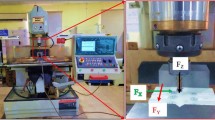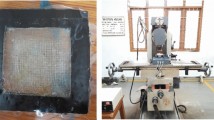Abstract
Machining of composite materials is usually performed to achieve required geometrical shapes and dimensional tolerances. However, machinability evaluation of glass fibre-reinforced polymer (GFRP) composites in end milling has not yet received its due attention in the research community despite the extensive industrial use of this process. This work aims to elucidate the end milling machinability of GFRP composites with respect to surface roughness, tool life and machining forces. Experiments were conducted under different experimental parameters and their levels according to the Taguchi design of experiment method. Taguchi analysis combined with statistical analysis of variance (ANOVA) was performed to quantify the effects of spindle speed, feed rate and depth of cut on those characteristics. Multiple regression analysis (MRA) was also employed to establish parametric relationships between the experimental parameters and the machinability outputs. Results from ANOVA and MRA reveal that feed rate is the governing factor affecting all the machinability outputs. The calculated values from MRA have been found to be fairly close to experimental values in almost all cases. Validation tests under randomly selected machining conditions have further demonstrated the feasibility of the developed mathematical models with 8–12% error for tool life and machining forces predictions while >19% error for calculating the surface roughness.
Similar content being viewed by others
References
Bhatnagar N, Nayak D, Singh I, Chouhan H, Mahajan P (2004) Determination of machining induced damage characteristics of fiber reinforced plastics composite laminates. Mater Manuf Process 19(6):1009–1023
Sheikh-Ahmad J, Sirdhar G (2002) Edge trimming of CFRP composites with diamond coated tools: edge wear and surface characteristics. In: SAE General Aviation Technology Conference and Exhibition, Wichita, Kansas
Bhattacharyya D, Horrigan DPW (1998) A study of hole drilling in Kevlar composites. Compos Sci Technol 58(2):267–283
Bhattacharyya D, Allen MN, Mander SJ (1993) Cryogenic machining of Kevlar composites. Mater Manuf Process 8(6):631–651
Enemouh EU, El-Gizawy AS, Okafor AC (2001) An approach for development of damage-free drilling of carbon fiber reinforced thermosets. Int J Mach Tools Manufact 41:1795–1814
Rawat S, Attia H (2009) Wear mechanisms and tool life management of WC-Co drills during dry high speed drilling of woven carbon fibre composites. Wear 267:1022–1030
Davim JP, Mata F (2005) Optimisation of surface roughness on turning fibre-reinforced plastics (FRPs) with diamond tools. Int J Adv Manuf Technol 26(4):319–323
Palanikumar K, Karunamoorthy L, Karthikeyan R (2006) Assessment of factors influencing surface roughness on the machining of glass fiber-reinforced polymer composites. Mater Des 27:862–871
Santhanakrishnan G, Krishnamurthy R, Malhotra SK (1992) Investigation into the machining of carbon-fibre-reinforced plastics with cemented carbides. J Mater Process Technol 30(3):263–275
Palanikumar K, Karunamoorthy L, Manoharan N (2006) Mathematical model to predict the surface roughness on the machining of glass fiber reinforced polymer composites. J Reinf Plast Compos 25(4):407–418
Kim KS, Lee DG, Kwak YK, Namgung S (1992) Machinability of carbon fiber-epoxy composite materials in turning. J Mater Process Technol 32:553–570
Puw HY, Hocheng H (1993) Machinability test of carbon fiber reinforced plastics in milling. Mater Manuf Process 8(6):717–729
Hocheng H, Puw HY, Huang Y (1993) Preliminary study on milling of unidirectional carbon fibre-reinforced plastics. Compos Manuf 4(2):103–108
Davim JP, Reis P (2005) Damage and dimensional precision on milling carbon fiber-reinforced plastics using design experiments. J Mater Process Technol 160(2):160–167
Davim JP, Reis P, Antonio CC (2004) A study on milling of glass fiber reinforced plastics manufactured by hand-lay up using statistical analysis (ANOVA). Compos Struct 64(3–4):493–500
Inoue T, Hagino M, Matsui M, Gu L (2009) Cutting characteristics of CFRP materials with end milling. K Eng Mater 407–408:710–713
Rahman M, Ramakrishna S, Thoo HC (1999) Machinability study of carbon/PEEK composites. Mach Sci Technol 3(1):49–59
Razfar MR, Zadeh MRZ (2009) Optimum damage and surface roughness prediction in end milling glass fibre-reinforced plastics, using neural network and genetic algorithm. Proc Inst Mech Eng Part B: J Eng Manufact 223(6):653–664
Sheikh-Ahmad J, Twomey J, Kalla D, Lodhia P (2007) Multiple regression and committee neural network force prediction models in milling FRP. Mach Sci Technol 11(3):391–412
Ucar M, Wang Y (2005) End-milling machinability of a carbon fiber reinforced laminated composite. J Adv Mater 37(4):46–52
Gilpin A (2009) Tool solutions for machining composites. Reinf Plast 53:30–33
Park SH (1996) Robust design and analysis for quality engineering. Chapman & Hall, London
Ross PJ (1996) Taguchi technique for quality engineering—loss function, orthogonal experiments, parameter and tolerance design. McGraw Hill, New York
Roy RK (2001) Design of experiments using the Taguchi approach: 16 steps to product and process improvement. John Wiley and Sons, New York
Lin JT, Bhattacharyya D, Lane C (1995) Machinability of a silicon carbide reinforced aluminium metal matrix composite. Wear 181–183(Part 2):883–888
Noordin MY, Venkatesh VC, Chan CL, Abdullah A (2001) Performance evaluation of cemented carbide tools in turning AISI 1010 steel. J Mater Process Technol 116(1):16–21
Wang MY, Chang HY (2004) Experimental study of surface roughness in slot end milling AL2014-T6. Int J Mach Tools Manuf 44(1):51–57
König W, Graß P (1989) Quality definition and assessment in drilling of fibre reinforced thermosets. CIRP Annals 38(2):119–124
König W, Wulf C, Graß P, Willerscheid H (1985) Machining of fibre reinforced plastics. CIRP Annals 34(2):537–548
Klocke F, Koenig W, Rummenhoeller S, Wuertz C (1999) Milling of advanced composites. In: Jahanmir S, Ramulu M, Koshy P (eds) Machining of ceramic and composites. Marcel Dekker, Inc, New York
Armarego EJA, Brown RH (1969) The machining of metals. Prentice-Hall, New Jersey
Wang DH, Ramulu M, Arola D (1995) Orthogonal cutting mechanisms of graphite/epoxy composite. Part I. Uni-directional laminate. Int J Mach Tools Manufact 35(12):1639–1648
Lee ES (2001) Precision machining of glass fibre reinforced plastics with respect to tool characteristics. Int J Adv Manuf Technol 17(11):791–798
Author information
Authors and Affiliations
Corresponding author
Rights and permissions
About this article
Cite this article
Azmi, A.I., Lin, R.J.T. & Bhattacharyya, D. Machinability study of glass fibre-reinforced polymer composites during end milling. Int J Adv Manuf Technol 64, 247–261 (2013). https://doi.org/10.1007/s00170-012-4006-6
Received:
Accepted:
Published:
Issue Date:
DOI: https://doi.org/10.1007/s00170-012-4006-6




